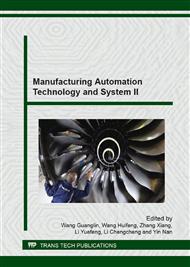p.127
p.134
p.140
p.146
p.153
p.158
p.165
p.171
p.181
Model-Based Design and Implementation of an Ultrasonic Elliptical Vibration Cutting Device
Abstract:
Due to intermitted cut characteristics, ultrasonic elliptical vibration cutting offers many benefits e.g. reducing tool force, improving surface finish and extending tool life. This paper presents the model-based development of an ultrasonic elliptical vibration cutting device with 1st resonant mode of longitudinal vibration and 3 rd resonant mode of bending vibration. The development of the device was assisted with the finite element program ANSYS. Based on theoretical and experimental studies, the requirements of the device are estimated. The maximum displacement amplitude of the ultrasonic elliptical vibration cutting device is 13.1μm and 8.3μm for bending vibration and longitudinal vibration respectively at an exciting voltage of 400Vp-p.
Info:
Periodical:
Pages:
153-157
Citation:
Online since:
August 2014
Authors:
Price:
Сopyright:
© 2014 Trans Tech Publications Ltd. All Rights Reserved
Share:
Citation:


